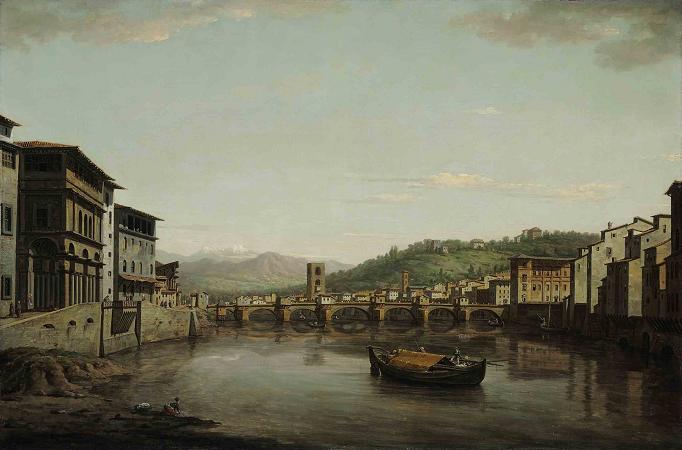Ponte Vecchio (c990). The Ponte Vecchio is a medieval stone closed-spandrel segmental arch bridge over the Arno River, in Florence, Italy, noted for still having shops built along it, as was once common. Butchers initially occupied the shops; the present tenants are jewelers, art dealers and souvenir sellers. The Ponte Vecchio's two neighbouring bridges are the Ponte Santa Trinita and the Ponte alle Grazie. The bridge spans the Arno at its narrowest point where it is believed that a bridge was first built in Roman times, when the via Cassia crossed the river at this point. The Roman piers were of stone, the superstructure of wood. The bridge first appears in a document of 996. After being destroyed by a flood in 1117 it was reconstructed in stone but swept away again in 1333 save two of its central piers, as noted by Giovanni Villani in his Nuova Cronica. It was rebuilt in 1345. Giorgio Vasari recorded the traditional view of his day that attributed its design to Taddeo Gaddi, besides Giotto one of the few artistic names of the trecento still recalled two hundred years later. Modern historians present Neri di Fioravanti as a possible candidate. Sheltered in a little loggia at the central opening of the bridge is a weathered dedication stone, which once read Nel trentatre dopo il mille-trecento, il ponte cadde, per diluvio dell' acque: poi dieci anni, come al Comun piacque, rifatto fu con questo adornamento. The Torre dei Mannelli was built at the southeast corner of the bridge to defend it. The bridge consists of three segmental arches: the main arch has a span of 30 meters the two side arches each span 27 meters. The rise of the arches is between 3.5 and 4.4 meters, and the span-to-rise ratio 5:1. It has always hosted shops and merchants who displayed their goods on tables before their premises, after authorization of the Bargello. The back shops that may be seen from upriver, were added in the seventeenth century. During World War II, the Ponte Vecchio was not destroyed by Germans during their retreat on the advance of the liberating British 8th Army on 4 August 1944, unlike all other bridges in Florence. This was allegedly, according to many locals and tour guides, because of an express order by Hitler. Access to Ponte Vecchio was, however, obstructed by the destruction of the buildings at both ends, which have since been rebuilt using a combination of original and modern design. Main article: Vasari Corridor In order to connect the Palazzo Vecchio with the Palazzo Pitti, in 1565 Cosimo I de' Medici had Giorgio Vasari build the Vasari Corridor above it. To enforce the prestige of the bridge, in 1593 the Medici Grand Dukes prohibited butchers from selling there; their place was immediately taken by several gold merchants. A decree was made in 1595 that excluded butchers from selling their meats from this bridge that is constantly applied to this day. The corporative association of butchers had monopolised the shops on the bridge since 1442. A stone with an inscription from Dante records the spot at the entrance to the bridge where Buondelmonte de' Buondelmonti was murdered on behalf of the Amidei, in 1215, initiating the urban fighting of the Guelfs and Ghibellines. In 1900, to honour and mark the fourth century of the birth of the great Florentine sculptor and master goldsmith Benvenuto Cellini, the leading goldsmiths of the bridge commissioned the most renowned Florentine sculptor of the time Raffaello Romanelli to create a bronze bust of Cellini to stand atop a fountain in the middle of the Eastern side of the bridge, where it stands to this day. Between 2005 and 2006, 5,500 padlocks, known as love locks, which were attached to the railings around the bust of Cellini, were removed by the city council. According to the council, the padlocks were aesthetically displeasing and damaged the bust and its railings. There is now a fine for attaching love locks to the bridge. The bridge was severely damaged in the 1966 flood of the Arno. The bridge is mentioned in the aria O mio babbino caro by Giacomo Puccini. Wall mural in Grossi Florentino, executed by students of Napier Waller under supervision.
more...






